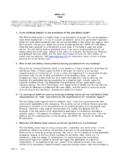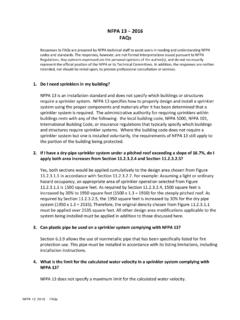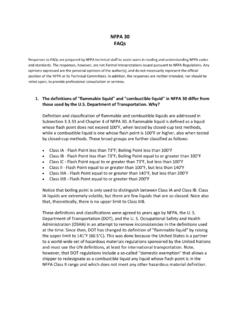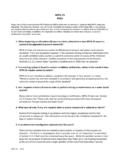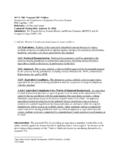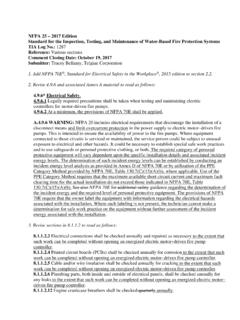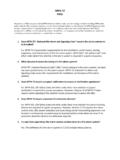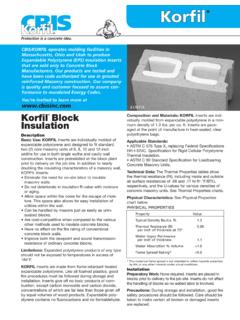Transcription of HOME ELECTRICAL FIRES
1 HOME ELECTRICAL FIRES Richard Campbell March 2019 Copyright 2019 National Fire Protection Association (NFPA) NFPA Research pg. 1 Key Findings FIRES INVOLVING ELECTRICAL FAILURE OR MALFUNCTION Local fire departments responded to an estimated average of 44,880 home FIRES involving ELECTRICAL failure or malfunction each year in 2012-2016. Home FIRES involving ELECTRICAL failure or malfunction caused an estimated average of 440 civilian deaths and 1,250 civilian injuries each year in 2012-2016, as well as an estimated $ billion in direct property damage a year.
2 ELECTRICAL distribution, lighting, and power transfer equipment accounted for half (50%) of home FIRES involving ELECTRICAL failure or malfunction, followed by cooking equipment (15%), heating equipment (9%), fans (6%), air conditioners (3%), and clothes dryers (3%). Nearly two of five FIRES (39%) involving ELECTRICAL failure or malfunction occurred in the cold weather months from November through February. These FIRES were less likely to occur in the overnight hours between midnight and 8 (22% of total), but FIRES during this time period accounted for 60% of the civilian deaths.
3 FIRES INVOLVING ELECTRICAL DISTRIBUTION AND LIGHTING EQUIPMENT1 Local fire departments responded to an estimated average of 35,150 home FIRES involving ELECTRICAL distribution and lighting equipment each year in 2012-2016. Home FIRES involving ELECTRICAL distribution and lighting equipment caused an estimated average of 490 civilian deaths and 1,200 civilian injuries each year in 2012-2016, as well as an estimated $ billion in direct property damage a year. Home FIRES involving ELECTRICAL distribution and lighting equipment most often originated in a bedroom (17% of total), attic or ceiling (12%), or a wall assembly or concealed space (9%).
4 Approximately one-quarter (24%) of these FIRES occurred between midnight and 8 , but these FIRES accounted for 60% of deaths. 1 Estimates exclude the six structure fire incident types for confined cooking FIRES , chimney or flue FIRES , fuel burner or boiler FIRES , incinerator, compactor, or trash FIRES . NFPA Research pg. 2 Home ELECTRICAL FIRES Home ELECTRICAL FIRES can start in wiring, ELECTRICAL distribution systems, and lighting equipment, as well as in any equipment powered by electricity such as cooking, heating, office and entertainment equipment, washers and dryers, as well as ELECTRICAL distribution or lighting equipment.
5 To better understand if these types of FIRES can be prevented through code changes, equipment changes, and/or public education, this report splits home ELECTRICAL FIRES into two groups, based on data from two separate data elements in the National Fire Incident Reporting System (NFIRS): 1. FIRES in which ELECTRICAL failure or malfunction is a factor contributing to ignition. 2. FIRES involving ELECTRICAL distribution and lighting equipment. These are FIRES in which ELECTRICAL distribution or lighting equipment are somehow involved in a fire s ignition.
6 The form of involvement could include ELECTRICAL failure or malfunction but may also involve other types of involvement, such as serving as a heat source by being in close proximity to combustible material or by overloaded equipment. Figure 1 shows the types of equipment involved in home FIRES in which ELECTRICAL failure or malfunction contributed to ignition. As indicated, ELECTRICAL distribution and lighting equipment accounts for half of these FIRES . 12%3%3%6%9%15%50%0%10%20%30%40%50%60%Oth er known equipmentClothes dryerAir conditionerFanHeating equipmentCooking equipmentElectrical distribution & lighting 1.
7 Home FIRES Involving ELECTRICAL Failure or Malfunction by Equipment Involved in Ignition 2012-2016 NFPA Research pg. 3 Home FIRES Involving ELECTRICAL Failure or Malfunction ELECTRICAL failures or malfunctions are a leading factor in the ignition of FIRES in homes. ELECTRICAL failures or malfunctions were responsible for 13% of home structure FIRES in 2012-2016, ranking as the second leading contributing factor behind FIRES caused by unattended equipment. ELECTRICAL failure or malfunction FIRES also accounted for nearly one-fifth (18%) of civilian deaths (the second leading contributing factor behind FIRES caused by heat sources too close to combustibles), 11% of civilian injuries, and accounted for the greatest share of direct property damage (20%).
8 TYPES OF ELECTRICAL FAILURE OR MALFUNCTION CONTRIBUTING TO THE IGNITION OF HOME FIRES As shown in Figure 2, home FIRES due to ELECTRICAL failure or malfunction primarily involve some form of arcing, which results from an unintentional discharge of ELECTRICAL current between conductors. Given sufficient time and level of current, arc faults can produce enough heat to ignite a fire. Arc faults are produced by damaged conductors and connectors and may involve damaged wiring, frayed appliance cords, loose connections in wall outlets, or faulty switches and junction boxes.
9 Arc faults may originate in different areas of the home or virtually any ELECTRICAL fixture or equipment. ELECTRICAL fault sparks fire that displaces residents An ELECTRICAL fault in a ceiling fan was blamed for an early morning fire in a multifamily residence. Firefighters were dispatched to the fire following a 911 call from one of the occupants after a smoke alarm in his unit activated just after midnight. On arrival, crews reported fire on the second floor of a two-and-a-half-story wood-frame structure. The fire escalated to four alarms before firefighters were able to knock it down.
10 News reports indicated that 11 occupants were displaced by the fire, but none were injured. One firefighter was reported to have suffered a back injury at the scene. Investigators determined that the fire was caused by an ELECTRICAL short circuit in a ceiling fan in a second-floor bathroom. The building was composed of five residential units. According to news reports, a city inspector indicated that he did not find the number of smoke alarms in the building that were required by municipal codes. The building did not have sprinkler protection.
